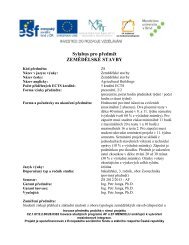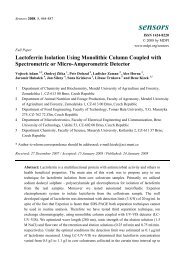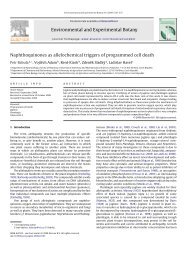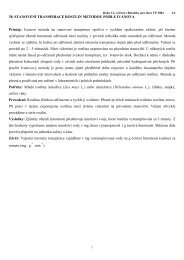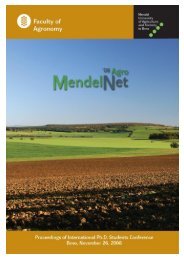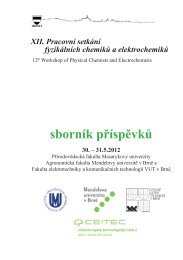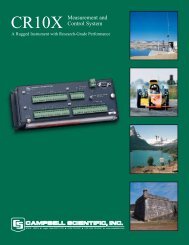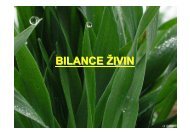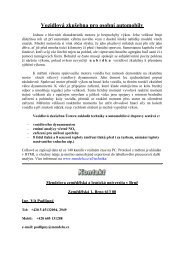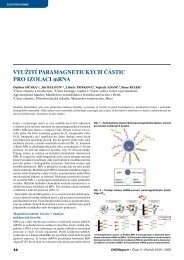PublikaÄnà Äinnost - Mendelova zemÄdÄlská a lesnická univerzita v ...
PublikaÄnà Äinnost - Mendelova zemÄdÄlská a lesnická univerzita v ...
PublikaÄnà Äinnost - Mendelova zemÄdÄlská a lesnická univerzita v ...
- No tags were found...
Create successful ePaper yourself
Turn your PDF publications into a flip-book with our unique Google optimized e-Paper software.
many different oily crops used for technical purposes, i.e. rape seed (canola), soybeans, and groundnut, sunfloweris the major one in many regions. For instance, long-term testing results have proven a feasibility of a regular turbocharged diesel engine operation on raw cold-pressed sunflower oil provided that the car is equipped with a doublefuel tank system. However, liquid biofuels based on chemically derived oily compounds, known as esters, are moresuitable as an environmentally friendly diesel substitute for general usage. Methyl- or ethyl-esters are usually blendedin mixtures with crude diesel oil and/or other mineral hydrocarbons (C8 – C12) because of economical reasons,even though operation on pure esters is accomplishable as well. Nevertheless, the processing technologies, variouscompounds and portions of the final blend are still under research and development in order to achieve an optimalperformance with lower emissions and a higher energy balance ratio (renewable output : fossil input). Moreover,there is also a potential for utilization of the by-products of agricultural and forestry sectors in terms of the biomassenergy. Generating rigid, liquid as well as gaseous fuels by pyrolisis and gasification can bring a new approach toproducing the green electricity and liquid fuels (BTL) generation using wastes or low cost by-products. The authors’goal is to compose a comparative study of the above listed approaches and technologies for the sunflower processingbased on physical and chemical properties, standardization and a global economy development with a highrespect to sustainability.PŘIDAL, A. – VESELÝ, P. Changes in the composition of the bee populations of the Mohelno Serpentine Steppeafter 70 years (Hymenoptera: Apiformes). Acta Universitatis Agriculturae et Silviculturae MendelianaeBrunensis. 2011. sv. 59, č. 6, s. 291–311. ISSN 1211-8516.Mohelno serpentine steppe (Mohelenská hadcová step) is a unique natural habitat of European importance. Sinceits last apidologic proper survey passed about 70 years. The objective of this work was to summarize the resultsof the apidological survey performed in the national nature reserve Mohelno Serpentine Steppe in a period of2010–2011, characterize current changes in the composition of bee populations and propose recommendations forthe management of this nature reserve. The survey was performed within 20 days and includes a total of 91 hoursof observations in the fi eld with exact records of survey localization and weather. A total of 2705 bee individualswere caught using an insect net and examined. 71 to 276 bee individuals were identifi ed on individual days ofmonitoring. The bee density varied in a range of 18.4–87.1 bees per hour of the pure time of sampling. A total of176 bee species were identifi ed. 115 bee species from the original list of 232 bee species were confi rmed by thissurvey (50 %). Species that were not confi rmed could disappear as a result of changes which have occurred in theSteppe biotope over the past 40 years or their disappearance is generally associated with changes in the populationof a particular species in Moravia. The disappearance of 17 % of unconfi rmed species (20 species) from the Steppeis very likely to occur but it is not associated with general changes in the population of these species in southernMoravia. 61 out of 176 bee species were recorded in the Steppe for the fi rst time. Pyrobombus lapidarius waseudominant. The highest dominance was observed for Halictus simplex as a representative of the solitary speciesand for Nomada succincta as a representative of cleptoparasites. However, the major part of cleptoparasites (66 %)was not confi rmed. The Shannon’s index (H’ = 3.97), Equitability (e = 0.77) and the Simpson’s index (c = 0.04)were determined for bee populations. The following species occurred on the Steppe: a) ubiquitous species with anabnormally small population (49 species) and b) steppe specialists (xerothermophile) with abnormally abundantpopulations and strongly competitive to ubiquitous species (9 species). The survey revealed a signifi cant decreasein the diversity of apidofauna on the Steppe, showing that the degradation change took place only partially and thatsome rare xerothermophile species on the Steppe were preserved. The composition of apidofauna still maintainsits predominant xerothermophile character. The results of the survey were used to propose recommendations formanaging the maintenance of the national nature reserve Mohelno Serpentine Steppe.ZEJDOVÁ, P. – WALTEROVÁ, L. – POLÁK, O. – FALTA, D. – CHLÁDEK, G. Zimní teploty stájového ovzduší a jejichvliv na mléčnou užitkovost dojnic. [CD-ROM]. In Animal Breeding, 2011. s. 163–169. ISBN 978-80-7375-446-4.V experimentu byl hodnocen průběh teplot stájového ovzduší (minimální, maximální, průměrné) ve vztahu k mléčnéužitkovosti. Sledování probíhalo od 1.2.2008 do 29.2.2008 na Školním zemědělském podniku v Žabčicích (49° 0’4”s. š. a 16° 36’ v.d., 179 m. n. m.). Pozorovaným objektem byla stáj pro dojnice Holštýnského plemene. V této stájibylo 45 dojnic v různé fázi (od 30. dne výše) i na odlišném pořadí (1.- 8.) laktace. Teplota byla měřena nepřetržitěv průběhu celého měsíce v 15 minutových intervalech pomocí šesti čidel HOBO. Čidla byla rozmístěna ve stáji,v životní zóně zvířat. Pro kontrolu bylo umístěno ještě jedno čidlo venku – kvůli sledování průběhu venkovní teplotyvzduchu. Kromě teploty stájového ovzduší byla sledována i mléčná užitkovost dojnic. Množství nadojeného mlékabylo zaznamenáváno při každém dojení (tj. 2 x denně). Data od všech krav byla denně zprůměrována. Zjištěné údajeo teplotě vzduchu i mléčné užitkovosti byly vyhodnoceny pomocí korelace. Mezi měřenými teplotami stájovéhoovzduší (maximální, minimální, průměrná) a denní produkcí mléka byla ve všech případech zjištěna slabě pozitivníkorelace, která byla nejsilnější u minimální teploty vzduchu (r = 0,235), poněkud méně výrazná u průměrné teplotyvzduchu (r = 0,139) a nejnižší u maximální teploty vzduchu (r = 0,086). Výše rozdílu mezi maximální a minimálníteplotou měla na mléčnou užitkovost dojnic pouze velmi slabě negativní vliv (r = – 0,144). ). Z výsledků lze usuzovat,43



